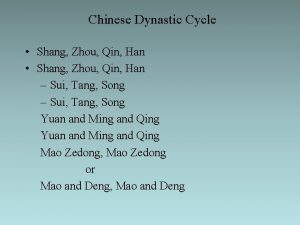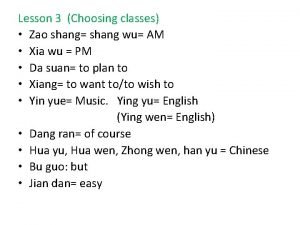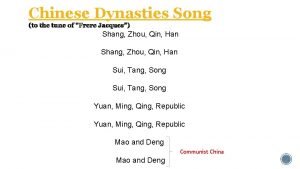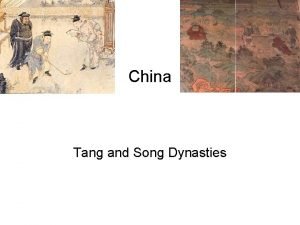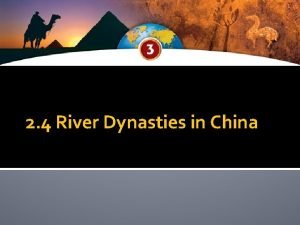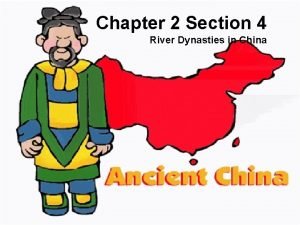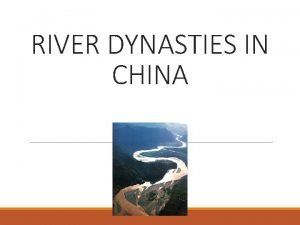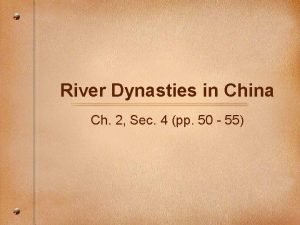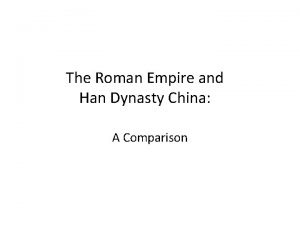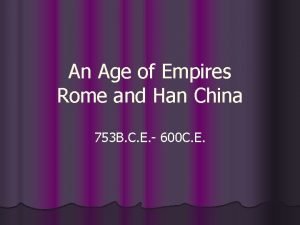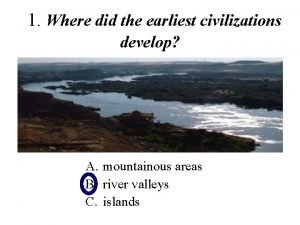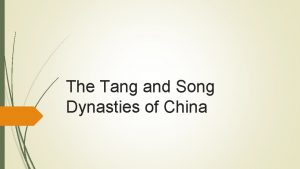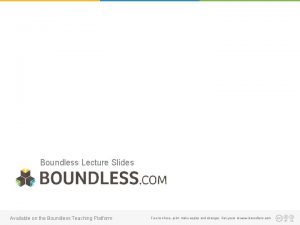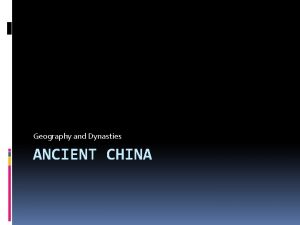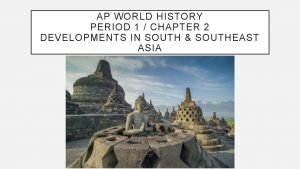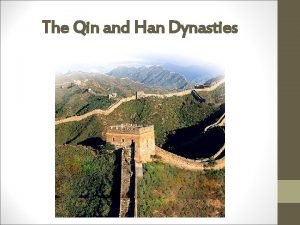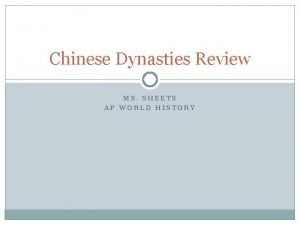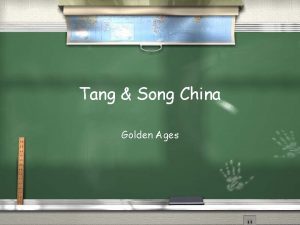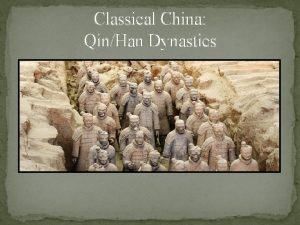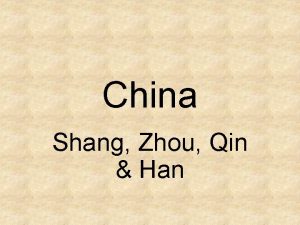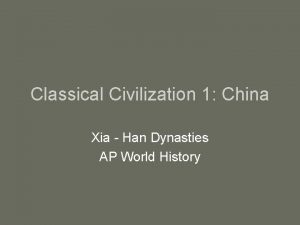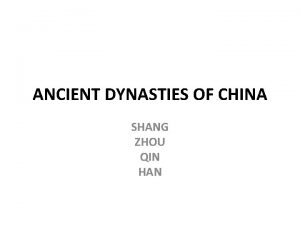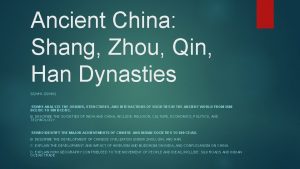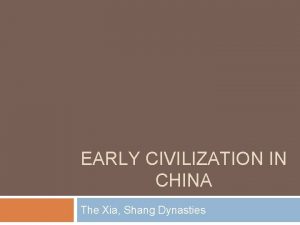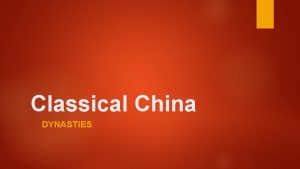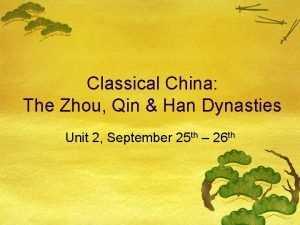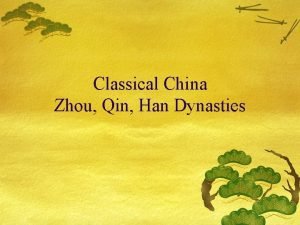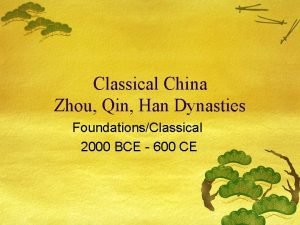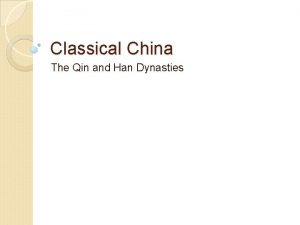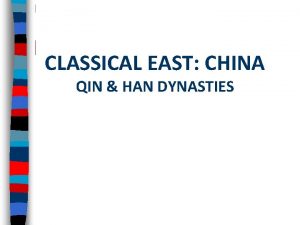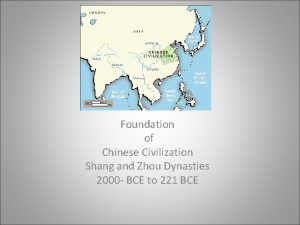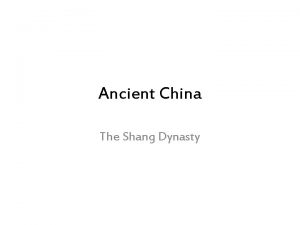Classical Civilization 1 China Shang Han Dynasties AP































- Slides: 31

Classical Civilization 1: China Shang - Han Dynasties AP World History

Chinese Dynasty Song Shang, Zhou, Qin, Han shang, joe, chin, hahn Sui, Tang, Song sway, tang, soong Yuan, Ming, Qing, Republic yooan, ming, ching, Republic Mao Zedong mou dzu dong

From Ancient to Classical Civ • Most ancient river valley civs declined after 1200 B. C. E. • The classical civilizations, which began to emerge around 1000 B. C. E. , were measurably different than their river valley predecessors. • They grew noticeably larger through trade and conquest. • Classical civilizations developed in China, India, Greece, and Rome. China was the 1 st and the largest of the classical civs. • Though all the classical civilizations had declined by 500 C. E. , they left an indelible mark on world civilization. Their impact endures to the present. • Great developments in philosophy, politics, and art in classical civilizations formed the foundation for subsequent civilizations. • Patriarchal culture prevailed in each of the classical civilizations.

Ancient Chinese Civilization • Chinese civilization along the Huanghe (Yellow River) developed in relative isolation, save for some overland trading with India and the Middle East. • By around 1500 B. C. E. a line of kings called the Shang ruled over the Huanghe valley. They began the dynastic cycle that would endure until the 20 th century.


Dynastic Cycle • Dynastic cycle lasted from 1700 BCE until the early part of the 20 th century. • Dynasty=family of kings. • 3 Dynasties of classical China: Zhou, Qin, and Han.

Shang (1700 - 1027 BCE) • • First recorded Dynasty Ruled by a belligerent aristocracy First Chinese cities, center of court life Villages organized by clans, not nuclear families. Cast bronze, created silk Developed writing. Ideas through pictographs. Thousands of characters. Honored ancestors, used oracle bones Shang tyrant emperor overthrown by Zhou, who ushered in the 2 nd dynasty.

Shang Bronzes

Dao • Early Chinese philosophy stressed the basic harmony of nature: every feature is balanced by an opposite (yin and yang). For hot there is cold, for male, female. • Forms basis for Daoism, a philosophy by which a individual seeks a way, called Dao, to relate to this harmony, avoiding excess and appreciating balance of opposites.


Zhou (Chou) (1027 - 250 BCE) • Longest lasting Chinese Dynasty. • First classical era dynasty. • First period of territorial expansion (complicated problems of central rule). • Featured decentralized politics but important cultural innovations incl. Confucianism, Mandate of Heaven, and Chinese language. • Est system of currency • China’s feudal period (rulers gave land to their supporters in exchange for defense).

Zhou Coins - bronze

Zhou (Chou) (1027 - 250 BCE) • Zhou rulers claimed direct links to the Shang rulers. • Also asserted that heaven had transferred its mandate to rule China to the Zhou emperors. Mandate of Heaven. • Mandate of Heaven remained a key justification for Chinese imperial rule in all subsequent dynasties (think Divine Right). • Promoted linguistic unity via a standard spoken language (Mandarin Chinese). Largest single group of people speaking the same language in the world at this time.


Confucius • As a wondering scholar-philosopher in Zhou China, Kung Fuzi (Confucius) undertook a quest to become chief advisor to a ruler who possessed the wisdom to restore centralized control, peace, and order in his realm (like Aristotle philosopher-king). • Though he never fulfilled this goal in his lifetime, his students preserved, spread, and debated his teachings after his death in the early 5 th c B. C. E. , and compiled his teachings in the Analects. (Consider Greek philos, the Buddha, and Jesus’ disciples). • His social and political teachings formed the basis for one of humanity’s greatest and most enduring civs.

551 – 479 B. C. E. Born in the feudal state of Liu. Became a teacher and editor of books.

Confucianism 101 • Idealized strong rulers and consolidation of polit power. • Advocated rule by highly educated, exclusively male elite (think Aristotle). • Began as an ethical rather than religious system. • Est norms for all aspects of Chinese life, from familial relationships, filial piety, ancestor veneration, and male authority. • Est norms for etiquette of rulers and scholar bureaucrats. • Influenced art, music, calligraphy. I • Formed basis of Chinese philosophical and religious beliefs for more than 2000 years.



Zhou (Chou) (1027 - 250 BCE) • The breakdown of the Zhou dynasty’s ability to control its vassals in the 8 th c B. C. E. led to a long period of political conflict – land-owning aristocrats solidified their own power base and disregarded the govt. • Warring States Period- feudal lords compete for power (almost 30 years!)

Qin (221 - 207 BCE) • Qin Shi Huangdi , meaning First Emperor. • Brings an end to the “Warring States Period” • China (Name comes from) • Brutal yet effective. Organized China into large provinces ruled by bureaucrats. • Used Legalism = harsh punishments and laws on the basis that humans are greedy and evil

Qin (221 - 207 BCE) • For defense, built first Great Wall (Ming built other part later), extending 3000+ miles. Largest construction project in human history • Adopted Legalism: only way to achieve order was to pass strict laws and impose harsh punishments. ( created by Hanfeizi) • Ordered national census, standardized currency, weights measurements, laws, and unified written characters • Banned Confucianism, burned books. Attacks on intellectuals and high taxes made him fiercely unpopular.


Han (202 BCE - 221 CE) • After Shi Huangdi’s death, massive peasant revolts broke out. Two peasants led a revolt against Qin oppression, toppling the dynasty, giving rise to the Han dynasty. • Lasted for 400+ years. Most effective, & most enduring bureaucracy in the preindustrial world. • Legalism replaced by Confucianism • Introduced civil service examination (process of selecting govt officials based on merit rather than noble birth). • Limited the power of emperor (checks & balances) • Expanded Chinese territory into Korea and central Asia. Silk Roads developed, opens trade

Han (202 BCE - 221 CE) • Peace brought great prosperity. • Wu Ti erected shrines to Confucius, and he was established as a god. Confucianism becomes the official state philosophy. • Buddhism introduced, paper invented • Huge increase in population • Govt sponsored public works projects including complex irrigation & canal systems. • Not highly militaristic.


221 - 581 (CE) • Decline: weak leaders + nomadic invaders • Han dynasty overturned by a nomadic tribe, the Huns • Warlords control china - no centralized gov’t • Non-Chinese nomads control much of China

Review: Religion and Philosophy • • • Confucianism Daoism Legalism Buddhism Confucianists & Daoists tolerated each other. You could be politically a Confucianist & spiritually a Daoist.

Economy & Society • Considerable gap btwn landed elite and the masses (peasant farmers). • Slavery existed, but waned after the Zhou dynasty. • 3 main social groups: – Landowning aristocracy (educated bureaucrats or mandarins) – Laboring masses (peasant farmers, urban artisans) – Mean people (unskilled laborers, performing artists). Required to wear green scarves for identification. Punished for crime more harshly. • Confucianism supported the patriarchy and strict social classes

Economy & Society • Trade became important during Zhou & Han. Focused on luxury items: silk, porcelain. • Confucian emphasis on learning and political service led to scorn of lives devoted to moneymaking. Therefore, wealthy merchants had low prestige in social hierarchy.

Economy & Society • Chinese civ evolved with very little outside contact. Most saw China as an island of civilization in a sea of barbarians with nothing to offer except threat of invasion. They saw no need to learn from other societies. • Spread of Buddhism is exception to this rule, b/c it came from India during & after the Han decline. • Chinese pioneered technologies that were later disseminated over much of Eurasia & northern Africa: paper & compasses. • Asian nomads disseminated these inventions over much of the globe, contributing to tech transformations in Japan, Rome, Mid East, & Eng. • China’s silk became valued in Middle East & Roman Empire. Trade of silk and other luxury products generated a network of roads thru ctrl Asia known as the Silk Road. Han actively encouraged Silk Road trade.
 What is the dynastic cycle in china
What is the dynastic cycle in china Zao shang hao jung wo
Zao shang hao jung wo Chinese dynasties in order song
Chinese dynasties in order song Tang and song dynasty venn diagram
Tang and song dynasty venn diagram River dynasties in china
River dynasties in china River dynasties in china chapter 2 section 4
River dynasties in china chapter 2 section 4 River dynasties in china
River dynasties in china Chapter 2 section 4 river dynasties in china
Chapter 2 section 4 river dynasties in china How did the sui and tang dynasties reunite china
How did the sui and tang dynasties reunite china Shang china
Shang china The han restore unity to china
The han restore unity to china East asia spice chart
East asia spice chart Roman empire china
Roman empire china Ancient china zhou dynasty
Ancient china zhou dynasty Rome and han china
Rome and han china Where did the earliest civilizations develop
Where did the earliest civilizations develop Empress wu accomplishments
Empress wu accomplishments Chinese dynasties
Chinese dynasties Han sui tang song
Han sui tang song Zhou dynasty geography
Zhou dynasty geography Sui dynasty achievements
Sui dynasty achievements Why were the tang and song dynasties golden ages
Why were the tang and song dynasties golden ages Bhakti movement ap world history
Bhakti movement ap world history Delhi sultanate summary
Delhi sultanate summary Chinese dynasties
Chinese dynasties Song
Song 618 song
618 song China qin dynasty map
China qin dynasty map Water clocks han dynasty
Water clocks han dynasty Sui tang and song dynasties
Sui tang and song dynasties Ap world history chinese dynasties
Ap world history chinese dynasties Golden age of tang and song dynasties
Golden age of tang and song dynasties
